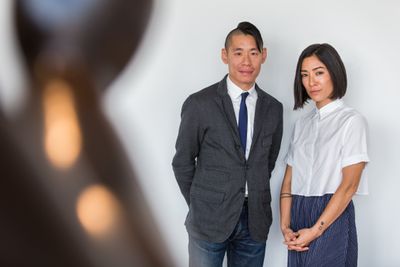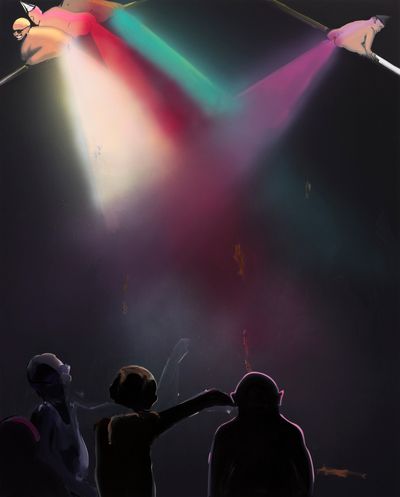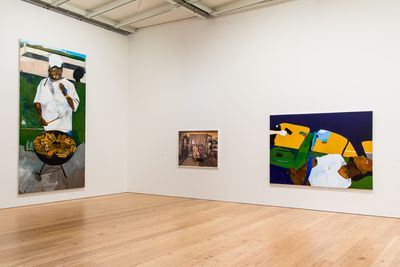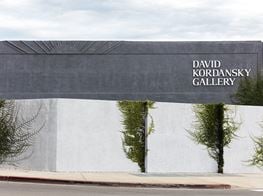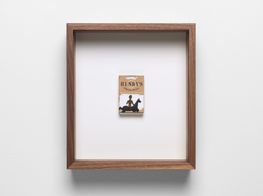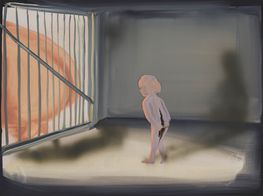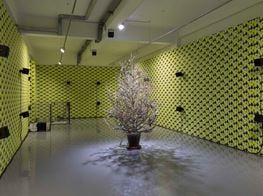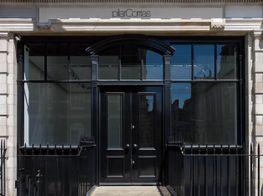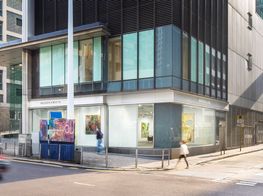Dismantling the show: the 2017 Whitney Biennial
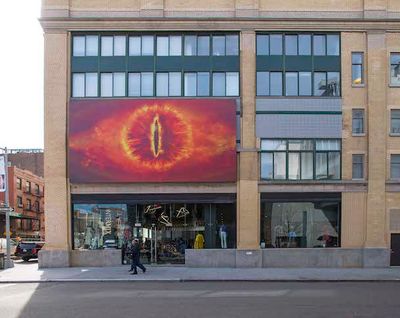
Puppies, Puppies Untitled (Sauron) (2017). Inkjet print on vinyl. 17 x 29 feet. Installation view: corner of Washington and Gansevoort Streets, Whitney Biennial 2017, New York (17 March–11 June 2017). Courtesy the artist; What Pipeline, Detroit; and Queer Thoughts, N.Y. Photo: Bill Orcutt.
Inaugurated in 1932, the Whitney Biennial is the United States' longest running survey of contemporary American art. As with many of its predecessors, the 2017 Whitney Biennial (17 March–11 June 2017) was controversial. The textures of this particular furor are strikingly similar to those incurred in the last Whitney Biennial, held in 2014. In that instance, the Biennial's curators invited a black woman artist, 'Donelle Woolford', to participate, fully aware that she is the fictional creation of white male artist Joe Scanlan. The ensuing scandal centred on questions of representation and identity, and saw the artist collective HowDoYouSayYaminAfrican? withdrawing from the Biennial in protest. (It should be noted that in an interview with Artnet, the collective described the entire nature of their participation and withdrawal as a protest.)
At the heart of the critical backlash towards Scanlan's project was the institutional tendency in the US to prefer white fantasies and fictions of 'the other' over the work and phenomenology of actual artists (especially women) of colour. In 2017, the Biennial included Dana Schutz's Open Casket (2016)—a painting of the infamous photograph of Emmett Till, a black 14-year-old who was lynched and mutilated by white adults Roy Bryant and J W Milam in 1955. In response, artist Parker Bright staged a protest in front of the work, wearing a T-shirt bearing the words 'BLACK DEATH SPECTACLE'. This was followed by an open letter to the Biennial curators written by Hannah Black and co-signed by 47 others, calling for the removal and destruction of the work. Fevered commentary on the open letter focused on the danger of censorship implied by the call for the painting's ruin. However, this controversy and the controversy that preceded it in the Biennial's 2014 edition expose a concerning continuity of the usurpation of black creative life (Donelle Woolford) and death (Emmett Till) in the name of unbridled artistic freedom. As Hannah Black put it in the open letter she addressed to the Whitney Biennial, conversations surrounding 'appropriation and representation go to the heart of how we might seek to live in a reparative mode, with humility, clarity, humor, and hope, given the barbaric realities of racial and gendered violence on which our lives are founded.'
Despite the aforementioned criticism, the 2017 Whitney Biennial, curated by Christopher Y Lew and Mia Locks (two young yet experienced curators and both Asian-Americans—a first for the Whitney Biennial, it should be noted), addressed many of the representational blind spots of which the Biennial has been a purveyor in the past. Set across five floors of the Whitney Museum of American Art and also other 'limited access' spaces—including an elementary school, onsite conference room, the museum's stairwell, and a billboard opposite the museum—the 78th Whitney Biennial featured the work of 63 artists and collectives working across diverse mediums, running the entire gamut from hand-whittled wooden constructions to virtual reality simulations. Of the participating artists and collectives, around half were women and people of colour. This has been the most diverse of any of the Whitney Biennials, a precedent which is in many ways contingent on the 1993 'multi-cultural Biennial'; the landmark exhibition curated by Elisabeth Sussman, John G Hanhardt, Thelma Golden and Lisa Phillips, described by the Guerrilla Girls as '... the first ever to have a minority of white male artists'. It was a biennial that elicited widespread and harsh criticism, some of which appeared to be rooted in a fear of a slowly diversifying art world, which is also perhaps relevant to the 24 years and more it has taken for the institution to adequately address the lack of diversity in their curatorial departments and exhibition programmes.
Lamentably, equitable representation is not reflected in contemporary art exhibitions or museum staff in this country or elsewhere. Precise figures are not available, but an approximate breakdown of ArtReview's 2016 Power 100 List is more than indicative of other patterns across the contemporary art sphere: 68% male, 32% female, 70% white, 16% Asian, 7% Latino, 5% black, and 3% Middle Eastern. Further, a 2016 report by New York City's Department of Cultural Affairs on the diversity of the city's arts sector identified that while the gender composition of the city matched that of the organisations, the ethnicity of staff did not: 62% were white when the percentage of population is just 44%, 15% black or African American versus 25% of the population, 10% Hispanic in a city that is 28% Hispanic and 8% Asian compared to 12%, according to the 2010 census. The effort on the part of the curators of the 2017 Whitney Biennial toward more equitable representation was not lost. Many of the artists included were new to the Whitney Museum, and the country-wide spread was a testament to the curators' research strategy, which included visits to artists' studios, dealers and curators in at least 40 cities. The national focus of the exhibition made for a certain coherence in some ways, in terms of experience, language, political realities and the specific legacies of oppression that continue to inform American society—not least in the operation of the art world.
The stated intention of the Biennial, which 'arrived at a time rife with racial tensions, economic inequities, and polarising politics' in the country, as the curators noted in their explanatory wall text, was to 'challenge us to consider how these realities affect our senses of self and community.' The curators went on to describe how works in the exhibition conferred certain realities of debt, violence, access to equal opportunities and reverence for the land. Despite the flattening and reductive nature of a singular text intended to describe over 60 works, there was a wealth of art with a concern for its socio-political possibilities, reality, and the everyday. A generous presentation by artist collective Occupy Museums stood as a form of (sanctioned or invited) institutional critique that spoke of the weight and sheer injustice of the debt that burdens many artists. As part of their 'Debtfair' project (2012–ongoing), the collective invited artists to submit testimonies and artworks to the website debtfair.org. At the Whitney, the artists' submissions were embedded in a partially deconstructed wall in the shape of a graph. The artist collective insists that the accumulation and burden of debt assures that artists 'become vehicles of growth for the wealthiest of the 1%—whether we share in the profits or not.' Yet the accompanying description of BlackRock chairman/CEO and MoMA trustee Larry Fink felt a little hollow in its calling out of a Whitney Museum competitor, despite the opportunities for a parallel critique of the host museum's dealings with exploitative capitalists (Steven Mnuchin, anyone?).
Analysis of socio-economic discrimination at the Biennial was combined with moments of comic relief, especially welcome in a skewering of white patriarchal heteronormative hegemony. Tala Madani's Shitty Disco (2016) is a hilarious depiction of naked male figures in a variety of compromising situations: four plump males straddling a beam (one grinning foolishly in black sunglasses) project disco lights out of their rears onto a dance floor. Her paintings—their titles peppered with puns—delight in their scatological renderings. Not far from Madani's presentation was a salon-style tiling of paintings and drawings by Celeste Dupuy-Spencer. The artist depicts her own basket of deplorables, shall we say, in Trump Rally (And some of them I assume are good people) (2016), the title a reference to Trump's infamous remarks about Mexicans when announcing his bid for the Republican party leadership. It depicts Trump supporters and right-wing extremists drawn in a clumsy manner, with the mass murderer Dylann Roof clearly recognisable among the crowd, under a banner that reads: 'Trump: 'Cause we don't know what the hell is going on!!!!'
A remarkable number of artworks spoke of realities often precluded from large museum exhibitions, including everyday instances of grief and joy, loss and resilience experienced within communities of colour. In one room, the divergent practices of photographer Deana Lawson and painter Henry Taylor shared space, reading almost as a two-person show. Lawson's work comprises highly-composed, large-format portraits of individuals: a bare-chested man holding a rifle next to his own family portrait; a woman and recumbently poised on the floor of what we assume is her family's living room, complete with children's toys in the background; and a young man embracing a tiny baby while a hand clutching a fistful of money is seen just to his left. The works eschew pervasive cultural conservatism and erasure, providing a representation of domestic spheres and black family life that mainstream media predominantly ignores or couches in racist terms, with ambivalent and detailed tableaus capturing, holding and often returning the viewer's gaze.
Henry Taylor's large-scale impressionistic paintings further nuance the cultural imagination in service of the heterogeneity of black life in America. The 4th (2012–2017) shows a figure manning a bountiful barbecue. Its title is a reference to the colloquial designation for the official holiday commemorating the 1776 Declaration of Independence, a designation preferred by many given the reality that the abolition of slavery in America did not happen for a further century. Another work by Taylor, THE TIMES THAY AINT A CHANGING FAST ENOUGH! (2017), depicts with graphic urgency a frame from Diamond Reynold's Facebook Live video stream that documented the fatal shooting of her partner Philando Castile at the hands of a police officer (who is represented in the image by a hand wielding a gun, which protrudes into the frame). The subject's eyes are strained, his body prone; we assume this is after the shot was fired. Taylor's fatalistic title calls out the ongoing oppression of the black population in America, at the hands of the police at least. The positioning of this painting among the grouping of Lawson's and Taylor's other works places Castile's killing within a trajectory of images that draw attention to the interdependency of anguish and existence, while presenting Castile's death as a moment and a lived reality (an especially dark one) that rippled throughout the entire American community. This room was a triumph on the part of the curators, as was the space appointed to the artist Cauleen Smith, which was situated on both the first and fifth floors. Smith's powerful, pained and beautiful flags aphoristically inscribe specific moments of black (female) experience. Made for procession, and with embellished metallic text spelling out elliptical phrases such as 'I have nothing left', 'I'm so black that I blind you', 'Rage blooms within me', and 'I cannot be fixed', Smith's flags sparkle and glimmer, transforming the agony of lived experience into quietly hopeful, enigmatic sentiments. 'We were never meant to survive' is a particularly potent example.
The Biennial's second-most controversial work was Jordan Wolfson's Oculus Rift piece, Real Violence (2017)—a 2:25-minute hyperrealistic virtual reality simulation of the artist senselessly beating another man kneeling on a New York City sidewalk. The explanatory text accompanying the work included the statement that 'Wolfson is interested in violence as a rupture or distortion of our everyday consciousness'. Here the artist and the curators effectively ignored the ways that violence is a constant and not a 'rupture' for many. One could safely argue that violence is the opposite of a distortion, given the ways it lays bare the systematic workings and injustices inherent in capitalism, and the way that capitalism capitalises on structural racism, sexism and difference in general. Further, the visual lexicon triggered by Real Violence includes depictions of violence against black bodies in mainstream media; this is particularly insensitive within the bounds of the exhibition itself, where directly one room before, and one floor below, the audience encounters representations of victims of very real and senseless violence. The work, and arguably the Biennial in its entirety, fails in its assumptions of its audience; it speaks mostly to a privileged white audience that is impervious to the spectre and actuality of structural and systemic violence (real or perceived) based on racial othering, and for whom the experience of institutionalised violence is not a chronic, or an inherited, experience.
Indeed, one could find a litany of alternative approaches to quantifying and representing the violence that is imbued in all aspects of life under neoliberal capitalism. Artist Cameron Rowland's project Public Money (2017) invested USD25,000 of the Whitney's funds in a Social Impact Bond called the Ventura Country Project to Support Reentry, aimed at reducing recidivism. Social Impact Bonds, pioneered in the UK under a wave of conservative-led austerity measures post-financial crisis, are contracts that reflect the privatisation of government social services to fill gaps in state financing. Rowland's project at the Whitney is an uncomfortable premise; it marries the social good of an anti-incarceration programme with the prospect of profit for the museum. The legal legitimacy of the project—the contracts for which were pinned into a frame and displayed for viewers' perusal—and the potential for positive outcomes for a beleaguered community, make for a compelling and morally-complicated work. Public Money sheds light on the network of private ownership, capital and the state—a relationship that has been fed and held in place by the arguable transformation of the institution of slavery into the prison-industrial complex.
As a whole, the 2017 Whitney Biennial was greater than the sum of its parts, though many works outshone others. The exhibition presented a myriad of conflicts and issues at the heart of contemporary American life—all of which are consequences of capitalism, greed, exploitation and fear. Struggles between the urban and pastoral, nature and the built environment (particularly invoked by found, uncanny architectural interruptions by Harold Mendez, and detailed photographic studies of Civil War film sets by An-My Lê), activism and capitalism, and of course Republican and Democrat, were prevalent. Yet, we have seen more times than we can count that these dichotomies are unfit to describe the complexities and intersectional features of our moment. It is also a position that suits the art institution, market and its benefactors, as the either/or binary assures they will always be the lesser evil. Late writer, feminist and civil rights activist Audre Lorde's wisdom that 'the master's tools will never dismantle the master's house' continues to ring true.
However, the hard work that many included artists have undertaken—over lifetimes in many cases—is proof of an opening-up of the structures of power and a chipping away at the bastions of conservatism, oppression, corruption and inequality that continue to characterise white, Western, patriarchal, heteronormative society. The curatorial project assembled here attempted to embody inclusiveness and broaden the museum's scope of engagement, while not shying away from antagonisms that surround us. We have realised that we cannot learn anything from the echo chamber, so let us hope that the impassioned and highly productive debate provoked by not just one controversial work in the Biennial continues to develop, beyond the confines of the exhibition and in our various realities.—[O]

